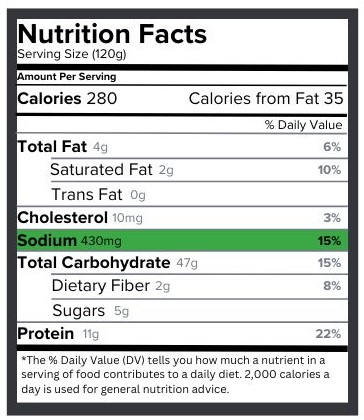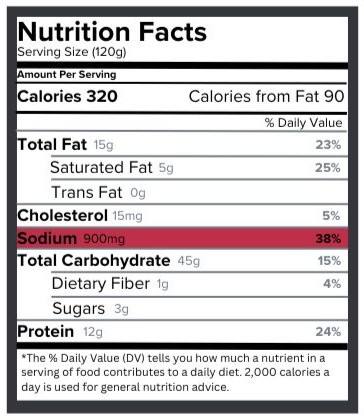DASH stands for Dietary Approaches to Stop Hypertension. It is a clinically proven diet plan that can lower blood pressure by a few points in as little as two weeks. In addition to lowering blood pressure, following the DASH Diet can reduce risk of heart disease, diabetes, stroke, osteoporosis, and some cancers.
How can you do it?
Reduce Sodium
The DASH Diet recommends no more than 2,300 mg of sodium per day. An obvious source of sodium is table salt, but other culprits include: deli meats, cheeses, chips, pretzels, popcorn, bread, soups, and many other processed/prepackaged foods. To reduce sodium, limit consumption of these high sodium choices, and never add table salt to food. There are many spices you can use to add flavor to dishes without adding extra sodium. Some of the best are: lemon juice, garlic powder, onion powder, pepper, oregano, basil, and paprika.
The Nutrition Facts Panel lists the amount of sodium per serving of a prepackaged food.
Low Sodium Choice

High Sodium Choice

What to eat
Grains
6-8 servings a day.Includes breads, pasta, rice, and cereal. Some examples of one serving of grains include: ½ c of pasta or rice or 1 slice of sandwich bread. Choose whole grains because they contain more fiber and nutrients than refined options. Some easy switches are buying brown rice rather than white rice, 100% whole-grain bread instead of white bread, and whole-wheat pasta in place of regular pasta.
Vegetables
4-5 servings a day.Serving size = 1 cup of leafy green vegetables; ½ cup raw or cooked vegetables.
Fresh, frozen, and canned vegetables are all great options. When buying frozen or canned make sure to buy products labeled “low sodium” or “without added salt.” Vegetables aren’t just a side dish – they can be a main course when served on a bed of brown rice!
Fruit
4 – 5 servings a day.Serving Size = 1 medium whole fruit; ½ cup of cut up fresh, frozen, or canned fruit
Fruit can be eaten with meals, as a snack, and even as a dessert! When buying canned fruit, look for products packed in water or 100% fruit juice. Don’t buy the ones packed in heavy syrup.
Dairy
2 – 3 servings a day.Choose low fat or fat free milk, yogurt, and cheese. Serving Size = 1 cup milk, 1 cup low fat yogurt, 1 ½ oz. low fat cheese.
Lean Meat, Poultry, and Fish
6 oz. or less per day.Choose meats like chicken, turkey, tuna, and other fish. Trim away skin and fat before cooking, and bake, roast, or grill instead of frying.
A 3oz. serving of meat is about the size of your palm. A good rule of thumb is to double your portion of vegetables, and eat half as much meat as you normally would.
Shop Smart
Serving Size
The portion of the label highlighted in baby blue indicates the amount of product in one serving. The nutrition information on the rest of the label is for one serving of the product.
Calories
Calories are the amount of energy contained in a food. Most people require about 2,000 calories a day. Consuming more calories than you need can lead to weight gain.
Nutrients to Limit
The section labeled in yellow is the section of nutrients that need to be limited. The American Heart Association recommends limiting saturated fat to fewer than 13g per day. Trans fat should be eliminated from the diet. Cholesterol should be limited between 200-300 mg per day, and no more than 2,300 mg of sodium should be consumed in a day.
Nutrients to Make Sure You Have Enough of
The label lists Fiber, Calcium, Vitamin D, Iron and potassium. These nutrients are necessary to maintain normal body functions.
Footnote
This explains the % Daily Values and are references for individuals following a 2,000-calorie diet.% Daily Values
This section is labeled in purple. It is also based on a 2,000-calorie diet and is a guide to determining whether the amount listed on the label is a large or small amount of that nutrient. 5% or less is a low amount. 20% or more is a high amount.